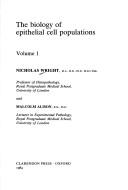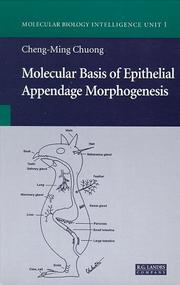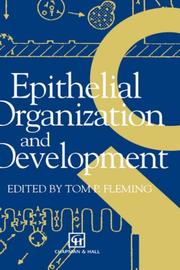| Listing 1 - 10 of 174 | << page >> |
Sort by
|

ISBN: 9780198575580 0198575580 Year: 1984 Publisher: Oxford: Clarendon,
Abstract | Keywords | Export | Availability | Bookmark
 Loading...
Loading...Choose an application
- Reference Manager
- EndNote
- RefWorks (Direct export to RefWorks)
Epithelium --- Cytology
Book
ISBN: 1107176549 1281040436 9786611040437 1139131435 0511334796 0511334141 0511333463 051154619X 0511335377 Year: 2007 Publisher: Cambridge ; New York : Cambridge University Press,
Abstract | Keywords | Export | Availability | Bookmark
 Loading...
Loading...Choose an application
- Reference Manager
- EndNote
- RefWorks (Direct export to RefWorks)
The endothelium, the cell layer that forms the inner lining of blood vessels, is a spatially distributed system that extends to all areas of the human body. Clinical and basic research demonstrates that the endothelium plays a crucial role in mediating homeostasis and is involved in virtually every disease, either as a primary determinant of pathophysiology or as a victim of collateral damage. The endothelium has remarkable, though largely untapped, diagnostic and therapeutic potential. This volume bridges the bench-to-bedside gap in endothelial biomedicine, advancing research and development and improving human health. The book is the first to systematically integrate knowledge about the endothelium from different organ-specific disciplines, including neurology, pulmonary, cardiology, gastroenterology, rheumatology, infectious disease, hematology-oncology, nephrology, and dermatology. It's interdisciplinary approach, which draws on expertise from such diverse fields as evolutionary biology, comparative biology, molecular and cell biology, mathematical modeling and complexity theory, translational research, and clinical medicine.
Book
ISBN: 9175192837 Year: 2011 Publisher: Linköping, Sweden : Linköping University,
Abstract | Keywords | Export | Availability | Bookmark
 Loading...
Loading...Choose an application
- Reference Manager
- EndNote
- RefWorks (Direct export to RefWorks)
Epithelium --- Cancer. --- Tumors. --- Treatment.

ISBN: 9781570594908 1570594902 Year: 1998 Publisher: Austin (Tex.): Landes,
Abstract | Keywords | Export | Availability | Bookmark
 Loading...
Loading...Choose an application
- Reference Manager
- EndNote
- RefWorks (Direct export to RefWorks)
Epithelium --- Molecular biology --- Morphogenesis
Book
Year: 1948 Publisher: New York Commonwealth Fund,
Abstract | Keywords | Export | Availability | Bookmark
 Loading...
Loading...Choose an application
- Reference Manager
- EndNote
- RefWorks (Direct export to RefWorks)
Article
Abstract | Keywords | Export | Availability | Bookmark
 Loading...
Loading...Choose an application
- Reference Manager
- EndNote
- RefWorks (Direct export to RefWorks)
CADHERINS --- CYTOLOGY --- EPITHELIUM

ISBN: 0412398907 9401050406 9401123543 9780412398902 Year: 1992 Publisher: London: Chapman and Hall,
Abstract | Keywords | Export | Availability | Bookmark
 Loading...
Loading...Choose an application
- Reference Manager
- EndNote
- RefWorks (Direct export to RefWorks)
Human physiology --- Cellules epitheliales --- Epitheelcellen --- Epithelial cells --- Epithelium --- Growth --- Differentiation --- growth and development --- anatomy and histology --- Epithelium - Growth. --- Epithelium - Differentiation. --- Epithelial cells. --- Epithelium - Growth --- Epithelium - Differentiation --- Epithelium - growth and development --- Epithelium - anatomy and histology

ISBN: 0897661958 9780897661959 Year: 1982 Volume: 401 Publisher: New York (N.Y.): New York Academy of Sciences,
Abstract | Keywords | Export | Availability | Bookmark
 Loading...
Loading...Choose an application
- Reference Manager
- EndNote
- RefWorks (Direct export to RefWorks)
Endothelium --- Congresses --- -#Lilly --- Epithelium --- #Lilly --- Endothelium - Congresses
Book
Year: 2001 Publisher: Bruxelles: UCL.,
Abstract | Keywords | Export | Availability | Bookmark
 Loading...
Loading...Choose an application
- Reference Manager
- EndNote
- RefWorks (Direct export to RefWorks)
Background. Ozone (O3) and nitrogen dioxide (NO2) are two highly reactive compounds that have already been shown to be injurious to human health, and particularly to the centro-acinar region of the lungs. Several studies have demonstrated that measurement of lung-specific secretory proteins in serum, fir instance the 16 kDa Clara cell protein (CC16) and the surfactant-associated protein A (SP-A) might be useful to assess alterations of the lung epithelial barrier following acute exposure to O3. However, no study has so far examined whether chronic exposure to photo-oxidants such as O3 and NO2 induces the same effects in humans.
Methods. 312 healthy non-smoking adults from areas with different ambient levels of O3 and NO2 were enrolled on this study. 78 subjects were from Cuernavaca North in the suburbs of Mexico, 95 were from Mexico City (Mexico) and 139 subjects from Paris (France). Each participant was followed for 5 days. NO2 exposure levels were assessed by personal passive monitors. Ambient O3 levels were measured by local monitoring stations. Blood samples were taken on days 5, in the morning, in order to assess the integrity of the lung epithelial barrier. CC16 was measured on the whole population. SP-A assay was performed on the Mexican population only.
Findings. Levels of ambient O3were singnificantly higher in the two Mexican areas (mean, 80 μg/m³/h) compared to Paris (mean, 30 μg/m³/h). No difference was however observed between the ambient NO2 concentrations. CC16 concentration in serum was on average 50% lower in the Mexican subjects compared to the subjects from Paris and showed an inverse dose-effect relationship with ambient O3 levels. By contrast, a slight increase in serum SP-A levels was found in the Mexican subjects and was positively correlated with O3 levels. CC16 and SP-A did not differ between the two Mexican groups.
Conclusions. This study shows that chronic exposure to O3 is associated with a decrease of CC16 I serum. As no relationship was observed with the NO2 concentrations, we assumed that O3 was the main constituent responsible for the observed effects. These observations, very similar to those observed within smokers suggest that chronic exposure to O3 is associated with epithelial lung injury
Air Pollution --- Environmental Exposure --- Lung Diseases --- Epithelium
Periodical
Abstract | Keywords | Export | Availability | Bookmark
 Loading...
Loading...Choose an application
- Reference Manager
- EndNote
- RefWorks (Direct export to RefWorks)
Epithelium --- Epithelial cells --- Biochemistry --- Microbiology --- Pharmacology
| Listing 1 - 10 of 174 | << page >> |
Sort by
|

 Search
Search Feedback
Feedback About UniCat
About UniCat  Help
Help News
News